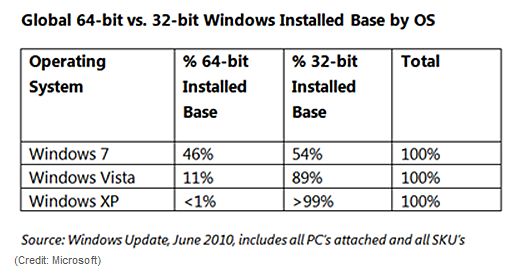
Chris has personally written over 2,000 articles that have been read more than one billion times-and that's just here at How-To Geek. And there would likely be no real standard for where developers installed different versions.Ĭhris Hoffman is the former Editor-in-Chief of How-To Geek.
#32 bit versions of windows install
If Windows used a single folder, the application's developer would have to have the 64-bit folder install to a different folder to keep them separate. The 32-bit version automatically installs to C:\Program Files (x86), and the 64-bit version automatically installs to the C:\Program Files. This also helps when a developer creates both 32-bit and 64-bit versions of an application, especially if both need to be installed at once in some situations. With the separate folders, that application won't be able to find the DLL at all, because the 64-bit version of Microsoft Office would be at C:\Program Files\Microsoft Office and the 32-bit application would be looking in C:\Program Files (x86)\Microsoft Office. However, if you had a 64-bit version of Microsoft Office installed, the application would crash and not function properly. A 32-bit application might go looking for a Microsoft Office DLL file found in C:\Program Files\Microsoft Office and try to load it. Keeping different program files for different CPU architectures separate prevents errors like these from happening.įor example, let's say Windows just used a single Program Files folder. 64-bit programs still use the normal Program Files folder.ģ2-bit programs can't load 64-bit libraries ( DLL files), and could crash if they tried to load a specific DLL file and found a 64-bit one instead of a 32-bit one. When you run a 32-bit program on a 64-bit edition of Windows, the WOW64 emulation layer seamlessly redirects its file access from "C:\Program Files" to "C:\Program Files (x86)." The 32-bit program tries to access the Program Files directory and is pointed to the Program Files (x86) folder. Windows runs 32-bit applications on 64-bit versions of Windows using something called WOW64, which stands for "Windows 32-bit on Windows 64-bit." So, 32-bit programs get installed to the "C:\Program Files (x86)" folder, instead.
#32 bit versions of windows software
However, 64-bit versions of Windows also support 32-bit programs, and Microsoft doesn't want 32-bit and 64-bit software getting mixed up in the same place. On 64-bit versions of Windows, 64-bit applications install to the Program Files folder. In other words, programs install to the Program Files folder. This Program Files folder is the recommended location where programs you install should store their executable, data, and other files.



On 32-bit versions of Windows-even 32-bit versions of Windows 10, which are still available today-you'll only see a "C:\Program Files" folder. Originally, Windows was only available as a 32-bit operating system.


 0 kommentar(er)
0 kommentar(er)
